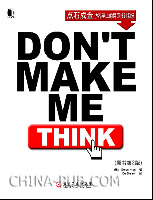《Don’t make me think》(不要让我思考)
《点石成金:访客至上的网页设计秘笈》

Contents(目录)
Rule #1 Don’t make me think(规则1:不要让我想)
How do we really use the Web?(我们如何使用网站?)
Designing pages for scanning, not reading(网页是用来扫描的,不是阅读的)
Rule #2 Mindless, unambiguous choice(规则2:不假思索的、明确的选择)
Rule #3 Get rid of half the words on each page(删除页面上的一半文字)
Designing navigation(设计导航系统)
Designing home page(设计主页)
Usability testing(可用性测试)
Krug’s first law of usability: Don’t make me think
As far as is humanly possible, a Web page should be self-evident, obvious, self-explanatory. I should be able to “get it” – what it is and how to use it – without expending any effort thinking about it.(只要可能,网页应该设计得清楚易懂。浏览者应该能够“理解”该网页——这个网页是关于什么的,如何使用它?——而不需要费力去思考。)
Using a site that doesn’t make us think about unimportant things feels effortless, whereas puzzling over things that don’t matter to us tends to sap our energy and enthusiasm—and time.(如果网站不需要浏览者就无关紧要的东西思考,那么该网站就可以说是不费力的。反之,该网站就会浪费浏览者的精力、热情和时间。)
Things that make us think(让我们思考的东西)
Names of things, like “job”, “employment opportunities” or “job-o-rama”.(事物的名称,比如“工作”、“就业机会”、“job-o-rama”)
Links and buttons that aren’t obviously clickable.(不显示为可以点击的超链接和按钮。)
Other things that visitors to a site shouldn’t spend their time thinking about, like:(其他访问者不应花费精力思考的东西,比如说:)
Where am I?(我在哪里?)
Where should I begin?(我应该从哪里开始?)
Where did they put ?(他们把***放在哪里了?)
What are the most important things on this page?(网页中最重要的东西是什么?)
Why did they call it that?(为什么他们要叫它那玩意儿?)
How do we really use the Web?(我们如何使用网站?)
Fact of life #1: We don’t read pages. We scan them.(事实1:我们不阅读网页,我们扫描网页。)
Fact of life #2: We don’t make optimal choices. We satisfice.(事实2:我们不会进行理想化的选择,而是选一个相对好的选项。)
Fact of life #3: We don’t figure out how things work. We muddle through.(事实3:我们不会费力去考虑事物工作的原理,而是会“摸着石头过河”。)
Designing pages for scanning, not reading(设计适合扫描,而不是阅读的网页
Create a clear visual hierarchy on each page(在每页中建立清晰的视觉框架和层次。)
Take advantage of conventions(利用设计惯例。比如说,可以参考书报杂志的设计惯例来设计网页。)
Break page up into clearly defined areas(把页面清楚的划分为不同的区域。)
Make it obvious what’s clickable(让可点击的东西清楚地显示出来,例如,让按钮“长”的像按钮。)
Minimize noise(尽量减少“污染”。例如,尽量不用背景音乐和背景图案;内容尽量不要凌乱地堆砌。)
Krug’s second law of usability
It doesn’t matter how many times I have to click, as long as each click is a mindless, unambiguous choice.(点击次数并不重要,只要每次点击都不需要思考(也就是说,点击的路径是很自然的、符合逻辑的)。
Krug’s third law of usability
Get rid of half the words on each page, then get rid of half of what’s left.(删除每页中一半的文字,然后把剩下的一半再删除一半。)
It reduces the noise level of the page.(这样可以减少网页中的“污染”源。)
It makes the useful content more prominent.(这样可以让有用的东西更清楚地显示出来。)
It makes the pages shorter, allowing users to see more of each page at a glance without scrolling.(这样页面就更短,浏览者可以不需要滚动就看到尽量多的内容。)
Designing navigation(设计导航系统)
The purposes of navigation(导航系统的作用)
It helps us to find whatever it is we’re looking for.(帮助浏览者找到需要的内容。)
It tells us where we are.(告诉浏览者其在网站中的位置。)
It gives us something to hold on to.(让浏览者能够有所依赖。)
It tells us what’s here.(告诉浏览者可以在这个网站中找到什么。)
It tells us how to use the site.(告诉浏览者如何使用这个网站。)
It gives us confidence in the people who built it.(让浏览者信任网站制作者。)
Web navigation conventions(Web导航惯例)
SiteID(站点徽标)
Sections(主要栏目)
Utilities (at least a way to go home and a way to search)(功能性工具,至少要让浏览者能够回到首页,并且提供搜索功能。)
Subsections(次要栏目)
“You are here” indicator and breadcrumbs(”您在这里”标记)
Page name(网页的名称,有时也叫做网页标题)
Local navigation(本地导航,也就是超链接)
Footnote navigation(页脚导航或“脚注”)
Try the trunk test (导航测试)
Imagine that you’ve been blindfolded and locked in the trunk of a car, then driven around for a while and dumped on a page somewhere deep in the bowels of a Web site. If the page is well designed, when your vision clears you should be able to answer these questions without hesitation:(假定把您眼睛蒙住,塞到汽车后备箱里,然后开车开一段时间,再把您扔到网站中的某个页面(有可能在网站的很深处)。如果页面的设计合理,当去掉您的遮眼布时,您应该能很容易地回答以下问题:)
What site is this? (Site ID)(这是个什么网站?)
What page am I on? (Page name)(我在哪个页面?)
What are the major sections of this site? (Sections)(这个网站都有哪些主要栏目?)
What are my options at this level? (Local navigation)(在这个层次上都有哪些选项?)
Where am I in the scheme of things? (“You are here” indicators)(我在整个网站中处于哪里?)
How can I search?(我怎么进行搜索?)
Designing home page(设计首页)
Things the Home page has to accommodate(首页上一般应包括的东西):
Site identity and mission(网站徽标和网站使命)
Site hierarchy(网站的层次结构)
Search(搜索功能)
Teases(吸引注意力的东西,attention grabber)
Timely content(实时的内容,类似“新闻”、“最近更新”等)
Deals(商业信息,例如广告)
Shortcuts(快捷方式,提供访问某些页面或功能的快速链接)
Registration(注册登录功能)
abstract objectives(一些抽象的目标)
Show me what I’m looking for.(告诉我我要找的东西在哪里?)
…and what I’m not looking for.(以及虽然我并没有找,但可能会吸引我的东西。)
Show me where to start.(告诉我从哪里开始,也就是如何去完成特定任务。)
Establish credibility and trust.(建立信任。)
Convey the big picture(传达蓝图信息)
As quickly and clearly as possible, the Home page needs to answer the four questions I have in my head when I enter a new site for the first time:(首页应该尽量快且清楚地回答以下四个任何浏览者都会问的问题:)
What is this?(这是个什么网站?)
What do they have here?(这个网站中有什么?)
What can I do here?(我能在这个网站做什么?)
Why should I be here—and not somewhere else?(为什么我要在这里,而不是别的什么地方?)
Four popular ways to spoil the Home page(四种搞砸首页的流行方法)
Putting a banner ad on the Home page if you don’t have to.(在没必要时,在首页上放个横幅广告条。)
Promoting everything.(推销所有的东西。)
Letting deals drive Home page design.(让广告驱动了首页的设计。)
Getting greedy for user data.(过于贪心得到用户信息。)
Usability testing(可用性测试)
Several sure things about testing(有关测试的正确说法)
If you want a great site, you’ve got to test.(如果想要一个好的站点,必须进行测试。)
Testing one user is 100 percent better than testing none.(测试一个用户比一个都不测试要好100%。
Testing one user early in the project is better than testing 50 near the end.(项目早期测试一个用户比结束时测试50个还有用。)
The importance of recruiting representative users is overrated.(不需要非要雇佣“具有代表性的用户”。)
The point of testing is not to prove or disprove something. It’s to inform your judgment.(测试的目的不是证实什么,而是对判断进行测试。)
Testing is an iterative process.(测试是一个循环的过程。)
Nothing beats a live audience reaction.(没有什么结果比真实用户的反映更好。)
Usability testing on 10 cents a day(1天10美分的可用性测试)
“Get it” test is just what it sounds like: show them the site, and see if they get it—do they understand the purpose of the site, the value proposition, how it’s organized, how it works, and so on.( “理解”测试:让用户看网站,看他们是否能理解站点的目标、站点的内容组织、站点的功能等。)
Key task testing means asking the user to do something, then watching how well they do.(”关键任务“测试:让用户具体完成某项任务,看他们如何做。
Cubicle tests(”工作间“测试:把页面设计给隔壁工作间中的同事让他帮着测试。)


























 被折叠的 条评论
为什么被折叠?
被折叠的 条评论
为什么被折叠?








